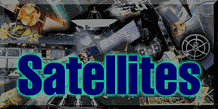![]()
|
|
|
|
|
|||||

Success Stories
A Satellites Success Story
Miriam Padolsky’s enthusiasm is infectious as she talks about the Satellites collection, produced under contract to SchoolNet Digital Collections (SDC). And it’s not just because she co-designed and produced the web site. "We’ve already received some e-mails from people who enjoyed the site," she says, citing the example of one user who spent two hours browsing the collection.
The project was carried out under contract to Industry Canada’s SchoolNet Digital Collections program, which gives people 15 to 30 years of age entrepreneurial and technology-based job experience converting collections of Canadian material into digital form for display on SchoolNet. The SchoolNet Digital Collections web site has grown to become possibly the largest single source of Canadian content on the Information Highway.
The site, which explores the roles and functions of satellites in daily life, is the result of five years of research. What began in 1992 as a high school project for the innovative Ottawa Board of Education Space Simulation program, expanded in form and scope to become a SchoolNet Digital Collections contract.
The contract was an opportunity for Padolsky and her Satellites partner, Hilary Myron to practice their business skills, it was also a unique opportunity to learn multimedia skills and profit from the experience. "We didn’t have any multimedia experience at all," admits Padolsky. "We’d used the Internet as users before, but never from a design perspective." The contract in turn gave rise to Padolsky’s own multimedia firm, Galactics, which she started with her partner Hilary Myron.
The challenge, Padolsky and Myron soon realized, was to create an instructive site that wasn’t full of technical jargon - they wanted students of all ages to enjoy the site, and share their enthusiasm for satellites.
The pair, fondly known by their friends as "Milary," left no stone unturned in their search for current and accurate information on satellites. "We researched in the resource room at the Museum of Science and Technology, and talked with a satellite expert," explains Padolsky. "We asked a lot of questions like, ‘How does a parabolic dish work’ and ‘What sort of material would you use?’ "
The result is nothing short of impressive. Satellites is more than a repository of information; it is an engaging site that captures the imagination. For instance, did you know that Canada was the third country in the world to launch a satellite into space, and has since been a recognized leader in the field?
Most Canadians would shake their heads no. This site fills an information gap that will undoubtedly impress both educators and students alike. In fact, this colourful web site was designed with students in mind. It features an extensive photo gallery, information utilities and a framed glossary which allows the user to check technical terms on any page of the site. In addition, the definitions from the glossary link to pages where you can find more information on a particular subject.
But perhaps most exciting of all is the Be Your Own Engineer section. Hosted by an original cartoon character, Engineer Susan, the section challenges users to design their own satellite based on what they have learned from the collection. To facilitate this process an on-screen notebook is framed so users can save and print their designs.
Terry Pritchett, an award winning educator and coordinator of the Space Simulation program, worked on the Satellites project as a volunteer consultant. He says the Satellites collection is an important educational tool, which he plans to use in his teachings. "It’s an invaluable source because it condenses a lot of information onto one site."
"If my experience in education
means anything, I think it would pay for businesses to check on these
kids in five to ten years," forecasts Pritchett. "This investment
in youth employment (by the SchoolNet Digital Collections Program) is
going to pay off in some very interesting ways."
|
Updated: |
